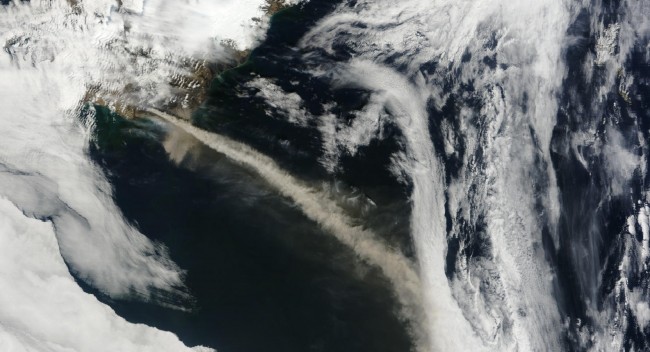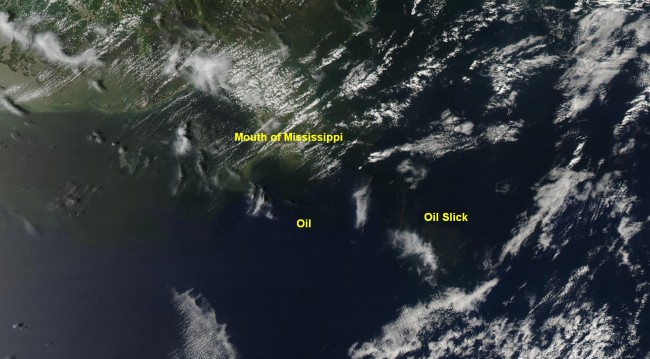7 May 2010
Oil and Ash from Space- Update
Posted by Dan Satterfield

NASA MODIS Satellite pass over the Iceland Volcano today. Huge ash cloud visible but it is not being blown toward Europe (as of now at least). Click image for much higher resolution.
The upper level winds are not blowing the ash toward the UK today and that is very good news. If they were, there would be widespread cancellations of flights. The cloud is especially thick.

One way to see the ash is to use a little trick. By looking at the brightness (temp.) difference between two channels on the image, the ash shows up very well. This is an animated gif, and will take awhile to load.
The good news is that late today the eruption has become much quieter and the ash is not as high as earlier.
Geological experts in Iceland are reporting that there are no signs the eruption will end anytime soon.
Sensors on most of the weather satellites are not really designed to see the ash. There has been a lot of work recently to use the available sensors to see as much as possible. The best way to see it is to use LIDAR. This is a form of radar using lasers. The UK Met office has had considerable luck using this from the ground to look at the ash cloud over the UK.
This event and the oil slick in the Gulf highlight the incredible usefulness of using remote sensing instruments in orbit. They pay for themselves many times over. The USA and Europe have fallen behind in putting these sensors on orbital platforms.
The technology is there, we just need to use it.
Here below is the latest view of the oil slick in the Gulf. Keep in mind you are only seeing the heaviest patch of oil. It is much more widespread than it appears.

True colour image from NASA's Aqua satellite. The thickest oil shows up well. It now appears the oil slick has moved west of the mouth of the Mississippi. Click image for much bigger view.
The movement of both the ash and the oil are very dependent on the atmospheric winds. The winds may start blowing the ash back toward Europe next week. The oil is much more difficult to predict…
Dan


 Dan Satterfield has worked as an on air meteorologist for 32 years in Oklahoma, Florida and Alabama. Forecasting weather is Dan's job, but all of Earth Science is his passion. This journal is where Dan writes about things he has too little time for on air. Dan blogs about peer-reviewed Earth science for Junior High level audiences and up.
Dan Satterfield has worked as an on air meteorologist for 32 years in Oklahoma, Florida and Alabama. Forecasting weather is Dan's job, but all of Earth Science is his passion. This journal is where Dan writes about things he has too little time for on air. Dan blogs about peer-reviewed Earth science for Junior High level audiences and up.